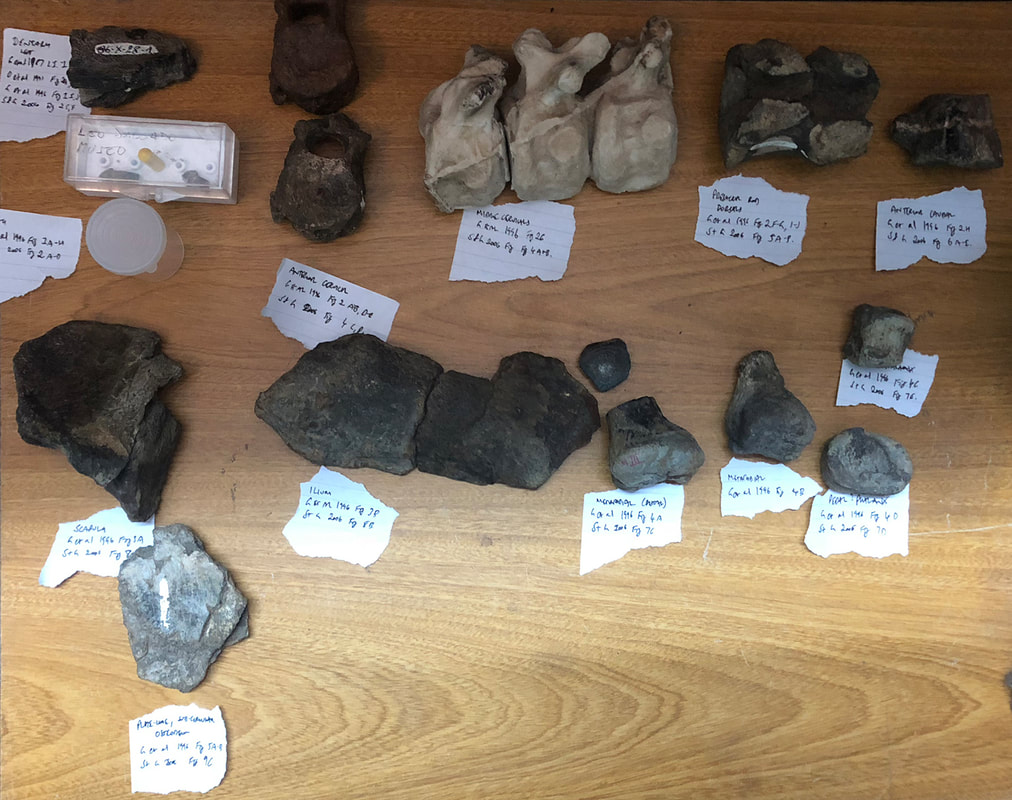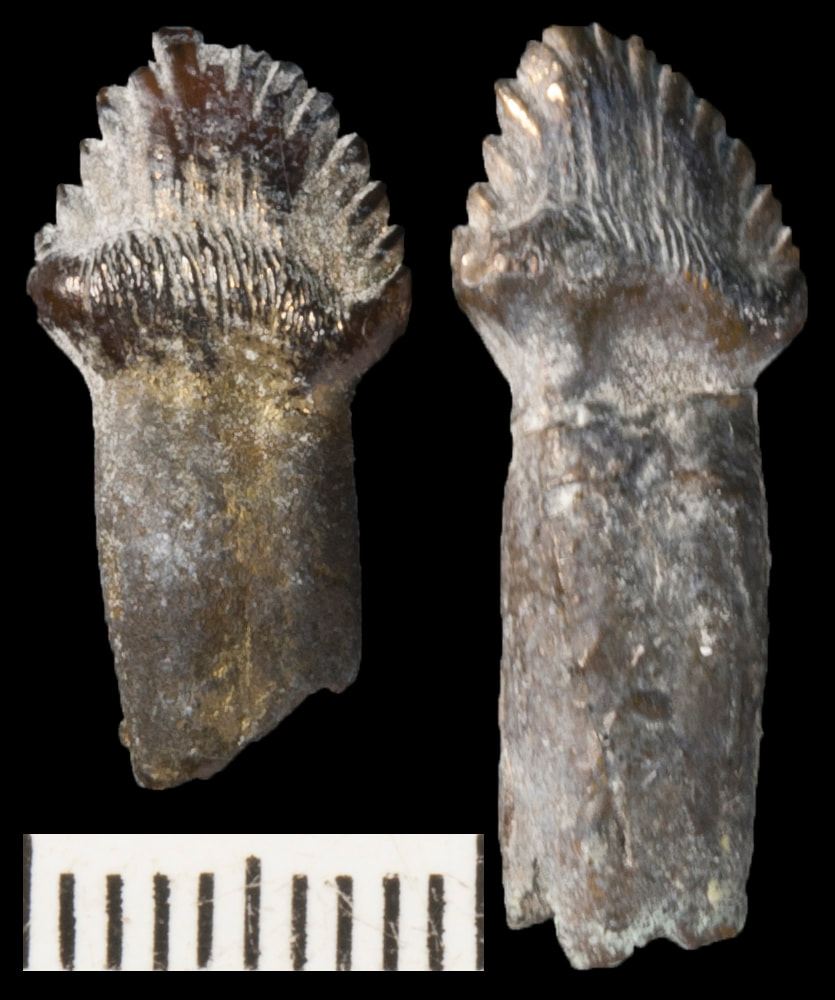|
It has been a while between posts; I can only apologise for that. Since I last posted, my phone died. Thankfully, though, that is the only new chapter in my technological horror story! On the plus side, since my last post I have also visited four museums/universities in three towns (Plaza Huincul, Cipolletti and Neuquén), as well as the Proyecto Dino Museum at Lago Barreales (where I could only get internet intermittently). I plan to visit one more museum while straddling Neuquén and Río Negro provinces (in Cinco Saltos) before departing for Trelew in Chubut Province on Friday. Between now and then, and also during the ~14 hour bus trip from Neuquén City to Trelew, I shall endeavour to summarise the past two-and-a-half weeks' work. First up, though, I will talk about the last of the dinosaurs I studied in La Plata: Antarctopelta oliveroi, the first (non-avian) dinosaur ever found in Antarctica. Before the 1980s, no Mesozoic dinosaur fossils had ever been found in Antarctica. Geological mapping and past fossil finds had demonstrated without doubt that Mesozoic rocks were present; however, to that point Mesozoic vertebrate fossils were only known from Lower Triassic rocks. This changed in January 1986, when Eduardo Olivero (Instituto Antartico Argentino) discovered a fragmentary — and rather severely permafrost-affected — dinosaur fossil in the Upper Cretaceous Santa Marta Formation on James Ross Island. By 1987, the specimen had been identified as an ankylosaur, and in July that year — at the 10th Brazilian Palaeontological Congress in Rio de Janeiro — its discovery was announced to the palaeontological community by Zulma Gasparini and colleagues. Its identity as an ankylosaur was well-established: the specimen included a partial jaw, teeth, vertebrae, and armour plates from the skull and body, all of which were extremely similar to other ankylosaurs known worldwide. However, the incompleteness of the specimen as a whole — and of each skeletal element recovered — made it difficult to determine where on the ankylosaur family tree the new form sat. Four years later, Olivero, Gasparini and colleagues summarised the research done to date on the ankylosaur, then discussed the implications of the dinosaur from an environmental and biogeographic perspective. The ankylosaur was found in a marine deposit. In layers both above and below that which produced the ankylosaur, the remains of marine reptiles had been identified, along with numerous marine invertebrate trace and body fossils. The discovery of both the ankylosaur and of fossil tree trunks and plant debris within the same rock formation suggests that land was not far away from this marine setting. As a consequence of this — and of known ankylosaur distribution at the time — Olivero and colleagues suggested that there was a continuous land bridge between South America and Antarctica during the Late Cretaceous. It was not until 1996 that a more complete description of the ankylosaur was published, by Zulma Gasparini and others, in the Proceedings of the Gondwanan Dinosaur Symposium (Memoirs of the Queensland Museum). Despite the fact that these authors described several skeletal remains — teeth, vertebrae, portions of pectoral and pelvic girdle, and numerous armour plates — they did not name the ankylosaur, and even suggested that two individuals were present based on apparent size discrepancies between some of the bones. Based on features of the teeth they suggested that the ankylosaur was a nodosaurid, and based on differences between it and Kunbarrasaurus ieversi (then known as Minmi sp.) they suggested that these two southern ankylosaurs were not closely related. Instead, they suggested that the Antarctic ankylosaur was an encroacher from the north, and that it — like hadrosaurian ornithopods — had established itself in South America during the Late Cretaceous American interchange. Finally, in 2006, Leonardo Salgado and Zulma Gasparini named the Antarctic ankylosaur Antarctopelta oliveroi (“[Eduardo] Olivero’s southern shield”). These authors supplemented the description published by Gasparini and colleagues in 1996 by describing new material, redescribing old specimens and providing numerous illustrations of previously unfigured elements. They also determined that all of the specimens were size-congruent and most likely pertained to a single individual. Intriguingly, they also identified some features unique to Ankylosauridae, as well as many nodosaurid characteristics. Consequently, they were unable to work out exactly where Antarctopelta sat on the ankylosaur family tree, making its biogeographic significance unclear. Having now seen the specimen firsthand, I can sympathise with all of the authors that have worked on this specimen in the past: it is difficult to interpret. Many of the bones are incomplete, others are poorly preserved, and some are both! The vertebrae and toe bones are quite well-preserved but not particularly informative, whereas the armour is poorly preserved and most pieces are incomplete. CT scanning of the dentary would probably assist in determining the morphology of the unerupted teeth therein; that said, there are at least two very well-preserved teeth that have already yielded much information. Unfortunately, because of my camera troubles — and my dash to Buenos Aires from La Plata on what was my final day in the latter — I did not get to study Antarctopelta as thoroughly as I would have liked. However, I did identify one bone that appears never to have been described or mentioned: the coracoid! Even after ~70 million years, it still clicks on to the scapula to form the shoulder girdle of this Antarctic ankylosaur. More to come; since I last posted I have studied three specimens of Megaraptor and most of the fossils assigned to three South American ornithopod genera (Anabisetia, Macrogryphosaurus and Gasparinisaura). I have also seen some gigantic sauropods (Argentinosaurus, Futalognkosaurus), a few not so gigantic sauropods (Andesaurus, Limaysaurus, Pilmatueia), and so many other type specimens that I can barely believe it (just yesterday, for example, I saw Abelisaurus, Bonitasaura, Buitreraptor, Rocasaurus...). I haven't had the time to study them all, of course, but I've been taking as many happy snaps as possible and will try to get through them all in time! References De Ricqlès, A., Pereda Suberbiola, X., Gasparini, Z. & Olivero, E., 2001. Histology of dermal ossifications in an ankylosaurian dinosaur from the Late Cretaceous of Antarctica. VII International Symposium on Mesozoic Terrestrial Ecosystems, Buenos Aires, 30-6-2001: Asociacíon Paleontológica Argentina, Publicatión Especial 7, 171–174. Gasparini, Z., Olivero, E., Scasso, R. & Rinaldi, C., 1987. Un ankylosaurio (Reptilia, Ornithischia) Campaniano en el continente Antarctico. Anais do X Congresso Brasil de Paleontologia, Rio De Janeiro, 19–25 Julho, 1987, 131–141. Gasparini, Z., Pereda-Suberbiola, X. & Molnar, R.E., 1996. New data on the ankylosaurian dinosaur from the Late Cretaceous of the Antarctic Peninsula. Memoirs of the Queensland Museum 39, 583–594. Olivero, E.B., Gasparini, Z., Rinaldi, C.A. & Scasso, R., 1991. First record of dinosaurs in Antarctica (Upper Cretaceous, James Ross Island): palaeogeographical implications. In Geological Evolution of Antarctica. Thomson, M.R.A., Crame, J.A. & Thomson, J.W., eds, Cambridge University Press, Cambridge, 617–622. Salgado, L. & Gasparini, Z., 2006. Reappraisal of an ankylosaurian dinosaur from the Upper Cretaceous of James Ross Island (Antarctica). Geodiversitas 28, 119–135.
2 Comments
2/23/2020 03:23:09 pm
Felicitaciones : Existe una diversidad de reconstrucciones en vida de Antartopelta Oliveroi , deseo saber las diferencias con el Sauropelta americano , ya que ambas reconstrucciones son muy similares.
Reply
Solicitar un préstamo ahora
1/23/2024 10:40:35 am
Buenos días señor / señora,
Reply
Leave a Reply. |
Stephen PoropatChurchill Fellow (2017) on a palaeo-tour of Argentina! Archives
December 2018
Categories |


 RSS Feed
RSS Feed
